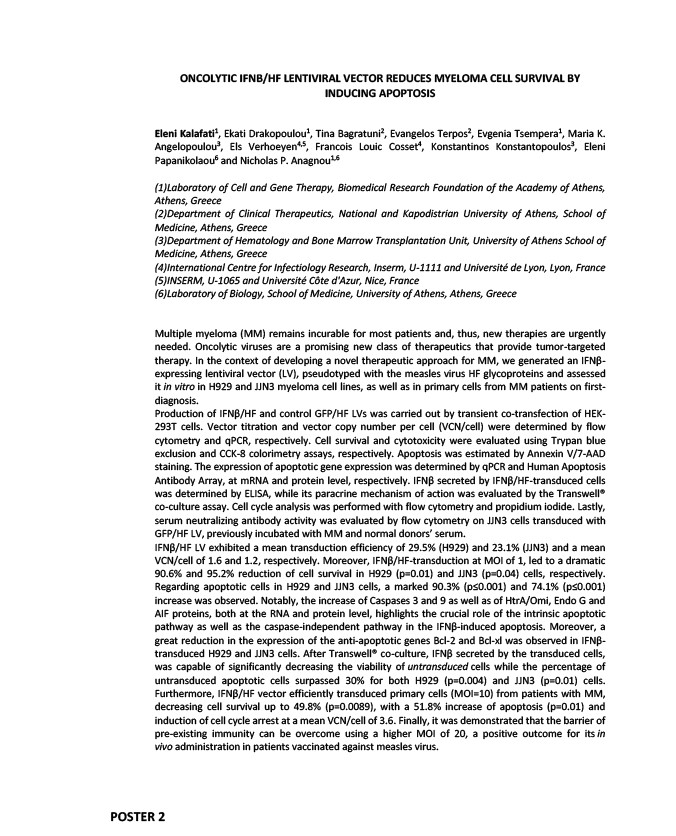
POSTER 2
ONCOLYTIC IFNΒ/ΗF LENTIVIRAL VECTOR REDUCES MYELOMA CELL SURVIVAL BY
INDUCING APOPTOSIS
Eleni Kalafati1, Ekati Drakopoulou1, Tina Bagratuni2, Evangelos Terpos2, Evgenia Tsempera1, Maria K.
Angelopoulou3, Els Verhoeyen4,5, Francois Louic Cosset4, Konstantinos Konstantopoulos3, Eleni
Papanikolaou6 and Nicholas P. Anagnou1,6
(1)Laboratory of Cell and Gene Therapy, Biomedical Research Foundation of the Academy of Athens,
Athens, Greece
(2)Department of Clinical Therapeutics, National and Kapodistrian University of Athens, School of
Medicine, Athens, Greece
(3)Department of Hematology and Bone Marrow Transplantation Unit, University of Athens School of
Medicine, Athens, Greece
(4)International Centre for Infectiology Research, Inserm, U-1111 and Université de Lyon, Lyon, France
(5)INSERM, U-1065 and Université Côte d'Azur, Nice, France
(6)Laboratory of Biology, School of Medicine, University of Athens, Athens, Greece
Multiple myeloma (MM) remains incurable for most patients and, thus, new therapies are urgently
needed. Oncolytic viruses are a promising new class of therapeutics that provide tumor-targeted
therapy. In the context of developing a novel therapeutic approach for MM, we generated an IFNβ-
expressing lentiviral vector (LV), pseudotyped with the measles virus HF glycoproteins and assessed
it in vitro in H929 and JJN3 myeloma cell lines, as well as in primary cells from MM patients on first-diagnosis.
Production of IFNβ/HF and control GFP/HF LVs was carried out by transient co-transfection of HEK-
293T cells. Vector titration and vector copy number per cell (VCN/cell) were determined by flow
cytometry and qPCR, respectively. Cell survival and cytotoxicity were evaluated using Trypan blue
exclusion and CCK-8 colorimetry assays, respectively. Apoptosis was estimated by Annexin V/7-AAD
staining. The expression of apoptotic gene expression was determined by qPCR and Human Apoptosis
Antibody Array, at mRNA and protein level, respectively. IFNβ secreted by IFNβ/HF-transduced cells
was determined by ELISA, while its paracrine mechanism of action was evaluated by the Transwell®
co-culture assay. Cell cycle analysis was performed with flow cytometry and propidium iodide. Lastly,
serum neutralizing antibody activity was evaluated by flow cytometry on JJN3 cells transduced with
GFP/HF LV, previously incubated with MM and normal donors’ serum.
IFNβ/ΗF LV exhibited a mean transduction efficiency of 29.5% (H929) and 23.1% (JJN3) and a mean
VCN/cell of 1.6 and 1.2, respectively. Moreover, IFNβ/HF-transduction at ΜΟΙ of 1, led to a dramatic
90.6% and 95.2% reduction of cell survival in H929 (p=0.01) and JJN3 (p=0.04) cells, respectively.
Regarding apoptotic cells in H929 and JJN3 cells, a marked 90.3% (p≤0.001) and 74.1% (p≤0.001)
increase was observed. Notably, the increase of Caspases 3 and 9 as well as of HtrA/Omi, Endo G and
AIF proteins, both at the RNA and protein level, highlights the crucial role of the intrinsic apoptotic
pathway as well as the caspase-independent pathway in the IFNβ-induced apoptosis. Moreover, a
great reduction in the expression of the anti-apoptotic genes Bcl-2 and Bcl-xl was observed in IFNβ-
transduced H929 and JJN3 cells. After Transwell® co-culture, IFNβ secreted by the transduced cells,
was capable of significantly decreasing the viability of untransduced cells while the percentage of
untransduced apoptotic cells surpassed 30% for both H929 (p=0.004) and JJN3 (p=0.01) cells.
Furthermore, IFNβ/HF vector efficiently transduced primary cells (MOI=10) from patients with MM,
decreasing cell survival up to 49.8% (p=0.0089), with a 51.8% increase of apoptosis (p=0.01) and
induction of cell cycle arrest at a mean VCN/cell of 3.6. Finally, it was demonstrated that the barrier of
pre-existing immunity can be overcome using a higher MOI of 20, a positive outcome for its in
vivo administration in patients vaccinated against measles virus.